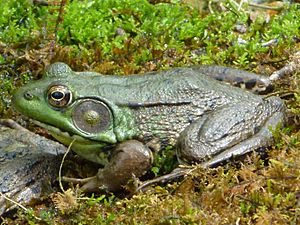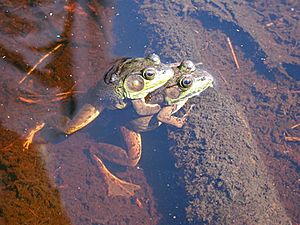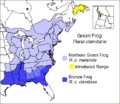Green frog facts for kids
Quick facts for kids Green frog |
|
|---|---|
 |
|
| Male, Tewksbury Township, New Jersey | |
| Conservation status | |
| Scientific classification | |
| Genus: |
Lithobates
|
| Species: |
clamitans
|
| Subspecies | |
|
See text |
|
 |
|
| Green frog range | |
| Synonyms | |
|
|
The green frog (Lithobates clamitans or Rana clamitans) is a type of frog that lives in eastern North America. There are two main kinds, or subspecies, of green frogs: the bronze frog and the northern green frog.
Contents
About the Green Frog
Green frogs are medium-sized frogs. Adult green frogs are usually about 5 to 10 centimeters (2 to 4 inches) long, not counting their back legs. They weigh between 28 and 85 grams (1 to 3 ounces).
Male and female green frogs look a bit different. Female frogs are usually bigger than males. Male frogs have a large eardrum, called a tympanum, which is about twice the size of their eye. In females, the eardrum is about the same size as their eye. Also, male green frogs have bright yellow throats.
You can tell a green frog from a bullfrog by looking at the ridges on its back. Green frogs have two clear, seam-like skin folds called dorsolateral ridges that run down their sides. Bullfrogs do not have these ridges.
Green frogs usually have green heads, but their bodies can be brown, gray, or dark green. Some frogs might only have green on the sides of their heads, while others are green all the way down their back. Their belly is white with black spots. When male green frogs are ready to breed, their throats turn yellow. Green frogs can change their color to be darker on colder days. This helps them soak up more heat from the sun. Sometimes, a green frog might look blue. This happens because of a special genetic change that stops the frog from making yellow colors. Since green is made of yellow and blue, without yellow, the frog looks blue!
Where Green Frogs Live
Green frogs live near shallow freshwater areas. You can find them in ponds, ditches, lakes, swamps, streams, and brooks. They might visit vernal pools (temporary ponds), but they usually do not lay their eggs there. These frogs are very good at finding new places to live, like swimming pools or man-made ponds.
You will often see green frogs resting along the edge of the water. If you get too close, they will quickly jump into the water. They might swim to the bottom or float on the surface with only their eyes showing. By living right where land meets water, green frogs can quickly escape from land animals that might try to eat them.
Green Frog Behavior
Green frogs usually sit on the shoreline facing the water. If something comes near, they quickly jump into the water. They might swim to the bottom or float with just their eyes above the surface. Green frogs are usually active during the day, but they can also be active at night when it is warm.
Green frogs start to wake up when daytime temperatures are above 10 degrees Celsius (50 degrees Fahrenheit). However, they will not start breeding until the weather stays warm.
Young green frogs, called tadpoles, eat tiny bits of food from the bottom of the water. They look for decaying plants and even eat dead animals. Tadpoles like to warm themselves in shallow water. If they get scared, they will swim to deeper water. Tadpoles are active even in winter and can be seen moving under the ice.
Green Frog Reproduction
Green frogs lay their eggs in places with permanent water. Male frogs will call out and protect their territory. Their call sounds like a single, plucked banjo string. Sometimes, they repeat the sound.
The breeding season for green frogs is from April to August.
When frogs mate, the male holds onto the female from behind. This is called amplexus. The female releases her eggs into the water, and the male releases his sperm at the same time. The sperm then swim to the eggs, and fertilization happens in the water. A female can lay a lot of eggs at once, sometimes between 1,000 and 7,000 eggs! These eggs might stick to plants under the water.
Green frog tadpoles are olive green with a creamy-white belly. They can change into frogs (metamorphose) in the same summer they hatch, or they might spend the winter as tadpoles and change the next summer. Male frogs can start breeding when they are one year old. Females usually start breeding when they are two or three years old.
What Green Frogs Eat
Green frogs will try to eat any animal that fits into their mouth and that they can catch. This includes insects, spiders, fish, crayfish, shrimp, other frogs, tadpoles, small snakes, slugs, and snails. Green frogs are "sit and wait" hunters. This means they wait for food to come close to them and then quickly grab it.
Tadpoles eat almost anything organic. This includes tiny plants called diatoms, algae, and very small animals like zooplankton.
Conservation Status
The green frog is one of the most common frogs in the places where it lives. There are no known major problems for this species. In some parts of the United States, green frogs are protected by law.
Types of Green Frogs
There are two recognized types of green frogs:
- Lithobates clamitans clamitans (Latreille, 1801) – This is known as the bronze frog.
- Lithobates clamitans melanota (Rafinesque, 1820) – This is known as the northern green frog.
Images for kids
See also
 In Spanish: Lithobates clamitans para niños
In Spanish: Lithobates clamitans para niños






